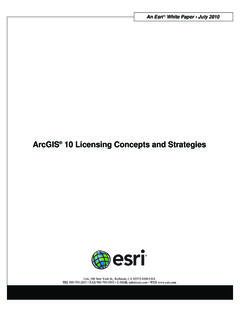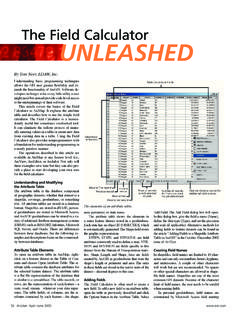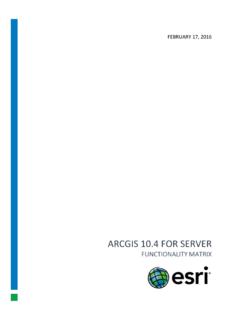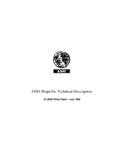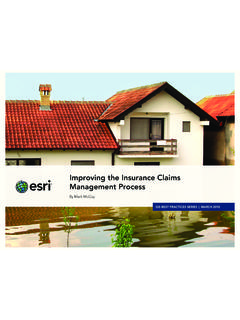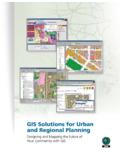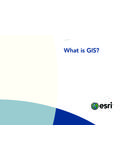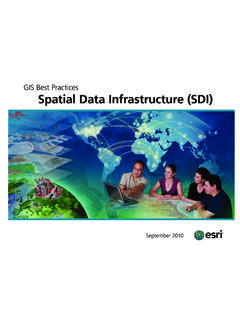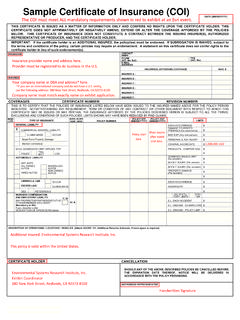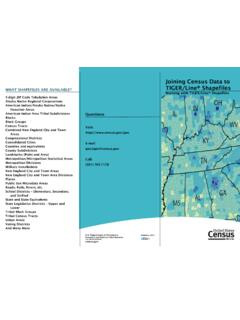Transcription of Advanced XLSForm Techniques - Esri
1 Brett Stokes, James Tedrick, Philip WilsonAdvanced XLSFormTechniquesAgenda Creating Editing Workflows with Survey123 Using Custom JavaScript Functions Polygon and Line Creation Creating Selectable Images using image-map Working with Photos in Survey123 Survey123 ConnectDefine your form in Excel using XLSF ormssyntaxPreview your XLSF ormin Connectwhen publishCreating Editing Workflows with Survey123 Our Workflows Asset Inspection Approving Incoming Data Key Concepts-Structure data to facilitate the workflow-Update existing features-Use multiple forms with one feature serviceCreate Surveys from Existing Feature Services Sign into a portal (ArcGIS Online/ArcGIS Enterprise) Select a feature service-Survey123 Connect scans and creates an XLSForm Edit the form to provide additional logic,create a form for just a repeat layer,remove questions Publish Your XLSF ilewill be automatically set with:-Settings: submission_url-Settings: Form_IDEdit Existing Survey Data Add the Inboxoption to the survey-Optional: can apply an expression to filter data This capability must be enabled on the survey BEFORE it is published Editing Existing Data with Survey123 videoSurvey123 ConnectEdit Existing Survey Data the Inbox You can query on fields and profile information, ex:-status= pending -assigned=${username}Survey123 ConnectField App Inboxfolder Submitted surveys retrieved from a list or map view-Surveys returned limited by max record count setting of feature service Select a survey to edit responsesAsset Inspection Prefer creating 2 tables-Asset table stores overall & important lifecycle information-Inspection table stores each inspection event Tables can be related in the geodatabase (1.)
2 M relationship)-Survey123 uses GUID-based relationships by default-Non-GUID can be accommodated via multiple-application workflowsAsset Inspection 2 types of forms Asset + Inspection-Survey123 Connect creates by default-Use the Inboxto load the assets in-Can carry over inspection history Inspection Only-Doesn't require Inbox-Doesn't require GUID-based relationship-Can be launched from other applicationsDEMOA pproving Incoming Data Easiest via multiple forms-Submittal-Review/Editing-Approval Fields can be hidden, removed or made read-only at each stage Add 'status' or other metadata fields to chart the progressMulti-stage forms Start with a table with all the questions used across the stage makes sure you have all the fields you need Create a form for each stage using the 'all' feature serviceCreate Stages First form include the 'status' fields as hidden to populate on submission Use the Inbox to only show those that need to be viewed at a stage Expose the status fields to allow the form to go to the next stage Use stages in another product (Dashbaord, Web AppBuilder).
3 Create feature layer views using the status fields to restrictDEMOF eature Service Form Settings Submission_url the service item s ARCGIS REST API entry Form_id The name of the table the top level of the form will submit data to These are found automatically when creating a survey from an existing Feature ServiceIdentifying Records Instance name Instance name setting enables field users to uniquely identify survey form Drafts, Outbox, Sent and Inbox folders in the Survey123 appsettings surveyWithout Instance nameWith Instance namePulldata() JavaScript FunctionsPulldata(@javascript)function (Beta feature) Thepulldata()function has been extended to work with your own JavaScript (JS) functions. An Advanced technique that can help you introduce logic beyond what is possible through standard XLSForm syntax. Invoke your own JS functions to return values and you decide what occurs within your JS function. The syntax for using your own JS functions with pulldata is as Custom JS files must be stored in a folder called 'extensions' within the survey directory.
4 Add as many function parameters as needed. In the example above, the JS function is expecting 2 parameters, but you could have more or less as needed by your own (@javascript)with repeats(Beta feature) A useful application is the ability to pass all the values from across all repeat records into your JS functions. The pulldata("@javascript", ..) function supports two different styles of implementation for retrieving the values from a repeat. 1. Repeat name - if a repeat name is passed in, the JS function will receive the parameter as an array of rows of all the values in the ("@javascript", " ", "yourFunction", ${repeat1}, "question1")2. Question from within a repeat -if a question from within a repeat is passed in, the JS function will receive an array of values from the specified ("@javascript", " ", "yourFunction", ${question1})Other pulldata(@javascript)properties(Beta feature) When using JS functions to access web services and secure ArcGIS services, some properties are not available through standard XLSF orms.
5 For this reason, we have also extended the collection of propertiesyou can obtain through the property() function as follows: property('propertyname )-portalurl- URL of ArcGIS Portal-Token - ArcGIS token-online - Boolean value indicating if device has network - Language in use by current - Locale object in use for current survey. Only useful for JavaScript AppStudio LocaleInfoobject for current survey. Language code reported in various Offset in minutes from UTC for the local : This can also be done in JavaScript via var utcOffset= - new Date().getTimezoneOffset-timezone- limitations(Beta feature) You cannot use DOM. You cannot use frameworks such as JQuery, Ember, Angular, etc. You cannot access local files. You cannot make asynchronous calls. You must be signed in. The survey must originate from the same ArcGIS organization as the signed in Line / Polygon geometry from repeated geopointsFun with shapes Starting at the release, your surveys can include lineand/or polygongeometry.
6 Simply add a geotrace or geoshape question to your XLSForm . Can use these surveys in field app or web app (but only publish from Connect).-support for adding line / area questions in web designer is coming in release. Only one parent geometry type for your survey (as per all esrifeature layers). Can include other geometry types if within a repeat (stored as related features).Geotrace (Line) & Geoshape (Polygon / Area) question typesCollecting Lines / Polygons Capture Methods: sketch or vertex-by-vertex-Specified in body::esri:style column of XLSForm (method=vertex or method=sketch).-Default is sketch, unless survey based on existing feature layer, then default is vertex. Digitize on screen. Collect vertices at GPS location in field app only (location streaming in future release).Capture Methods Fast, single take ieone pen stroke . Option to re-sketch or undo only (no edits). Smart shapes for regular geometries:-Ellipse, rectangle, triangle.
7 More control over geometry capture, vertices can be placed and edited with:-Screen clicks / taps, cross-hair, location sensor, geosearchbar. Entire geometry can be re-drawnSketchVertex Use a calculationexpression that returns a string of co-ordinate pairs. Each pair of co-ordinates describes a vertex of your line / polygon. Lat space Long (in decimal degrees), each pair separated by a (concat(${vertex_1},";",${vertex_2},";", ${vertex_3},";",${vertex_4},";",${vertex _5})) You can use the sum() function to sum geopointswithin a Lines / Polygons with Calculations-Each geopointis added to the line / polygon as a vertex in the order they are metadata can be collected for each limited to the Field App only. Edit existing Power Pole Condition Assessment survey. Add repeat around geopointquestion. Add geotrace question with sum() function in calculation column. Publish survey and open in field app. Begin capturing repeated geopointsand watch as the line / polygon is that GNSS metadata won t be populated if geopointsare added by digitizing on : Documentation Blog Post InformationCustomiseUI without any code Image map appearance Customise the UI of your survey without any code.
8 Enables fast and intuitive data collection with the user selections stored in the feature layer. Displays a Scalable Vector Graphic (SVG) image to interact with. SVGs can be edited / created to work perfectly with your survey. SVGs can have raster images (egJPG & PNG) embedded. Can add a big button experience to your survey very easily. Currently not supported in web designer / web works with select* questionsConsequenceLikelihoodAlmost / Create / Edit your SVG (more details to follow). a select_oneor select_multiplequestion to your the choice list as per the image-map appearance to your select* the SVG filename to the media::image the SVG file to your survey s Started with image-map An SVG file is an XML-based vector image format for two-dimensional graphics. Can be easily edited in any text editor, but using a vector graphics package will assist. They have support for interactivity and animation. SVGs can have raster image formats such as.
9 Pngand .jpg embedded within them. SVG <path> elements with an id value are required to work with Survey123. Each <path> element with id value becomes a clickable part of your survey. <path id> values match the name value in your select_one/ select_multiplechoice File format Must contain a <path> element that has an id <path>elements such as <rect>, <ellipse>, <circle>, <image> and <text> will not be clickable. Likewise,<path>elements without anid value will not be clickable. No empty empty groups ie <g> </g> within your SVG makes all<path>elements become un-clickable. Can only have 1 group per nest can have as many nested levels as you like, but if you have more than one group at a particular level (including the parent level), all of the<path>elements become un-clickable. SVG height and width (Viewport) must be defined. While your image will likely display properly without these, your clickable areas may become offset from the underlying image.
10 Viewbox(if specified) must match Viewport. You don't need to specify a 'viewBox' parameter in your <svg> element. However, if you do specify a viewBoxthat differs from your height and width values,your clickable areas will be offset from the underlying SVG requirements Open vector graphics editor (Illustrator, Inkscape,online SVG editors likeVectr,BoxySVGandDrawSVG). Import the raster image and resize page to selection (ensure scale=1) Create a simple object (egellipse) over one of the circles. Convert object to path and assign <path id> value Copy / Paste to cover all selectable areas. Save SVG to survey media folder and open in text editor to view contents. Open XLSF ormwithselect_multiplequestion. Add image-map appearance roselect_multiplequestion and SVG filename to media::image column. Refresh survey in Connect and : Documentation Blog Post Image-map Sample in Survey123 ConnectMore InformationWatermarksPhoto WatermarkingWatermark expressions in XLSformwatermark=ASSET ID: 44087\n@[latitude longitude:ddm]\nCompass@[compass]&size=2 5&color=red&outlineColor=whitewatermark= - Used in the bind:esri::parameters column to determine which information will be displayed on the ID: 44087 - freestanding text.
